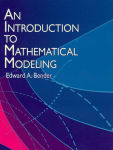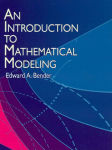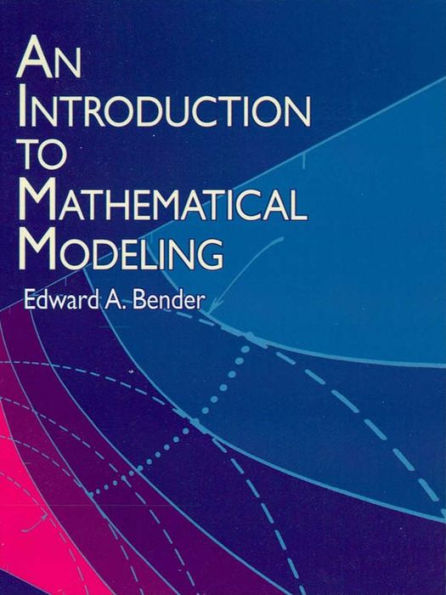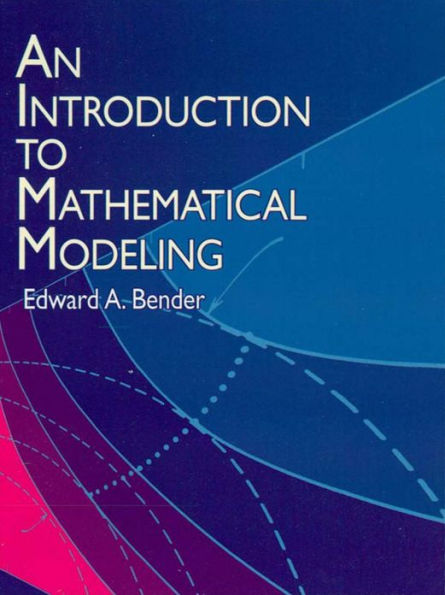Read an Excerpt
An Introduction to Mathematical Modeling
By Edward A. Bender Dover Publications, Inc.
Copyright © 1978 Edward A. Bender
All rights reserved.
ISBN: 978-0-486-13712-4
CHAPTER 1
WHAT IS MODELING
1.1 MODELS AND REALITY
The theoretical and scientific study of a situation centers around a model, that is, something that mimics relevant features of the situation being studied. For example, a road map, a geological map, and a plant collection are all models that mimic different aspects of a portion of the earth's surface.
The ultimate test of a model is how well it performs when it is applied to the problems it was designed to handle. (You cannot reasonably criticize a geological map if a major highway is not marked on it; however, this would be a serious deficiency in a road map.) When a model is used, it may lead to incorrect predictions. The model is often modified, frequently discarded, and sometimes used anyway because it is better than nothing. This is the way science develops.
Here we are concerned exclusively with mathematical models, that is, models that mimic reality by using the language of mathematics. Whenever we use "model" without a modifier, we mean "mathematical model." What makes mathematical models useful? If we "speak in mathematics," then
1. We must formulate our ideas precisely and so are less likely to let implicit assumptions slip by.
2. We have a concise "language" which encourages manipulation.
3. We have a large number of potentially useful theorems available.
4. We have high speed computers available for carrying out calculations.
There is a trade-off between items 3 and 4: Theory is useful for drawing general conclusions from simple models, and computers are useful for drawing specific conclusions from complicated models. Since the thought habits needed in formulating models are quite similar in the two cases, it matters little what sort of models we use; consequently, I have felt free to neglect computer based models purely for personal pedagogical reasons. There are some references to a computer in Section 5.2 where Monte Carlo simulation is discussed and, to a lesser extent, in Section 8.2 where numerical solutions to differential equations are discussed.
Mathematics and physical science each had important effects on the development of the other. Mathematics is starting to play a greater role in the development of the life and social sciences, and these sciences are starting to influence the development of mathematics. This sort of interaction is extremely important if the proper mathematical tools are going to be developed for the various sciences. S. Bochner (1966) discusses the hand-in-hand development of mathematics and physical science. Some people feel that there is something deeper going on than simply an interaction leading to the formulation of appropriate mathematical and physical concepts. E. P. Wigner (1960) discusses this.
1.2. PROPERTIES OF MODELS
We begin with a definition based on the previous discussion: A mathematical model is an abstract, simplified, mathematical construct related to a part of reality and created for a particular purpose. Since a dozen different people are likely to come up with a dozen different definitions, don't take this one too seriously; rather, think of it as a crude starting point around which to build your own understanding of mathematical modeling.
We now have a problem: To fully appreciate the general discussion in the next two sections you should look at some concrete examples like those in Sections 1.4 and 1.5; however, you will need some abstract background to appreciate the examples fully. I suggest reading the remainder of the chapter through quickly and then coming back to this point and rereading more carefully.
As far as a model is concerned, the world can be divided into three parts:
1. Things whose effects are neglected.
2. Things that affect the model but whose behavior the model is not designed to study.
3. Things the model is designed to study the behavior of.
The model completely ignores item 1. The constants, functions, and so on, that appear in item 2 are external and are referred to as exogenous variables (also called parameters, input, or independent variables). The things the model seeks to explain are endogenous variables (also called output or dependent variables). The exogenous-endogenous terminology is used in some areas of modeling. The input-output terminology is used in areas of modeling where the model is viewed as a box into which we feed information and obtain information from. The parameter-independent-dependent terminology is the standard mathematical usage.
Suppose we are hired by a firm to determine what the level of production should be to maximize profits. We would construct a model that enables us to express profits (the dependent variable) in terms of the level of production, the market situation, and whatever else we think is relevant (the independent variables). Next we would measure all the independent variables except the level of production and use the model to determine which value of the level of production gives the greatest profit.
Now let's look at things from the point of view of an economist who is seeking to explain the amount of goods firms produce. A two-part model could be constructed: Firms seek to maximize profits, and profits can be determined as sketched in the previous paragraph. In this model profits become an internal variable (of no interest except for the machinations of the model), and level of production changes from an independent to a dependent variable.
These three categories (neglected, input, and output) are important in modeling. If the wrong things are neglected, the model will be no good. If too much is taken into consideration, the resulting model will be hopelessly complex and probably require incredible amounts of data. Sometimes, in desperation a modeler neglects things not because he thinks they are unimportant, but because he cannot handle them and hopes that neglecting them will not invalidate the conclusions. A. Jensen (1966) discusses the development of a model for safety-at-sea problems. The main difficulty in formulating the model was to determine what types of encounters between ships were dangerous, that is, to separate items 1 and 2. He found this to be hard even with the aid of nautical experts. (If you want to know the answer, you'll have to read the article.)
Proper choice of dependent variables (i.e., output) is essential; we must seek to explain the things we can explain. Often this choice is relatively clear, as in the example involving the economist who wished to explain the level of production of a firm. Sometimes we need to be careful; for example, we could explain profits in terms of level of production, but not conversely as we might naively try to do, since we were asked to determine the best level of production.
Since different models make different types of simplifying assumptions, there is usually no single best model for describing a situation. R. Levins (1968, p. 7) observed that "it is not possible to maximize simultaneously generality, realism, and precision." In the social sciences one is often content with a statement that something will increase; precision has been sacrificed for realism and (hopefully) generality. Simulation models usually try for precision and realism but sacrifice generality. These three trade-offs should become clearer after you have studied some actual models.
Definitions of the variables and their interrelations constitute the assumptions of the model. We then use the model to draw conclusions (i.e., to make predictions). This is a deductive process: If the assumptions are true, the conclusions must also be true. Hence a false prediction implies that the model is wrong in some respect. Unfortunately things are usually not this clear-cut. We know our model is only an approximation, so we cannot expect perfect predictions. How can we judge a model in this case?
A conclusion derived from a crude model is not very believable, especially if other models make contrary predictions. A result is robust if it can be derived from a variety of different models of the same situation, or from a rather general model. A prediction that depends on very special assumptions for its validity is fragile. The cruder the model, the less believable its fragile predictions.
You may notice that we have talked about conclusions, not explanations. Can a model provide explanations? This is a somewhat philosophical question, and different people have different notions of what constitutes an explanation. Let us grant that, in some sense, models can provide explanations. A decision about the validity of a model is usually based on the accuracy of its predictions. Unfortunately, two different models may make the same predictions but offer different explanations. How can this be?
We can think of the situation we are modeling as being a "black box" which outputs something for every input. ("Something" can be no output.) A model makes correct predictions if it outputs the model equivalent of the black box output whenever the model equivalent of the black box input is fed in. The mechanism is irrelevant when dealing with predictions, but the nature of the mechanism is the heart of an explanation. Although there is usually a situation in which two different models lead to different predictions, we may not be able to determine which prediction is correct. For example, a model of a politician can be constructed by assuming that his behavior is (1) motivated by concern for his fellow man or (2) motivated by a desire for public office. In many situations these two models lead to identical or very similar predictions. It may be difficult to make contradictory predictions that can be checked. Another example for those familiar with simple circuits is the mathematical equivalence between perfect springs and perfect LC circuits. Although the underlying mathematics is identical, no one would seriously suggest that Hooke's law for springs "explains" the circuit's behavior.
We have been talking about an ideal modeler. When any of us approaches a problem, we do so in a limited, biased fashion. The more open-minded, communicative, and creative we can be, the better our model is likely to be. The following poem illustrates the problems that can arise.
The Blind Men and the Elephant
It was six men of Indostan
To learning much inclined,
Who went to see the Elephant
(Though all of them were blind),
That each by observation
Might satisfy his mind.
The First approached the Elephant,
And happening to fall
Against his broad and sturdy side,
At once began to bawl:
"God bless! but the Elephant
Is very like a wall!"
The Second, feeling of the tusk,
Cried, "Ho! what have we here
So very round and smooth and sharp?
To me 'tis mighty clear
This wonder of an Elephant
Is very like a spear!"
The third approached the animal,
And happening to take
The squirming trunk within his hands,
Thus boldly up and spake:
"I see," quoth he, "the Elephant
Is very like a Snake!"
The Fourth reached out an eager hand,
And felt about the knee.
"What most this wondrous beast is like
Is mighty plain," quoth he;
"'Tis clear enough the Elephant
Is very like a tree!"
The Fifth who chanced to touch the ear,
Said: "E'en the blindest man
Can tell what this resembles most;
Deny the fact who can,
This marvel of an Elephant
Is very like a fan!"
The Sixth no sooner had begun
About the beast to grope,
Than, seizing on the swinging tail
That fell within his scope,
"I see," quoth he, "the Elephant
Is very like a rope!"
And so these men of Indostan
Disputed loud and long,
Each in his own opinion
Exceeding stiff and strong.
Though each was partly in the right
And all were in the wrong!
John Godfrey Saxe (1816–1887)
Reprinted in Engineering Concepts
Curriculum Project (1971)
1.3. BUILDING A MODEL
Model building involves imagination and skill. Giving rules for doing it is like listing rules for being an artist; at best this provides a framework around which to build skills and develop imagination. It may be impossible to teach imagination. It won't try, but I hope this book provides an opportunity for your skills and imagination to grow. With these warnings, I present an outline of the modeling process.
1. Formulate the Problem. What is it that you wish to know? The nature of the model you choose depends very much on what you want it to do.
2. Outline the Model. At this stage you must separate the various parts of the universe into unimportant, exogenous, and endogenous. The interrelations among the variables must also be specified.
3. Is It Useful? Now stand back and look at what you have. Can you obtain the needed data and then use it in the model to make the predictions you want? If the answer is no, then you must reformulate the model (step 2) and perhaps even the problem (step 1). Note that "useful" does not mean reasonable or accurate; they come in step 4. It means: If the model fits the situation, will we be able to use it?
4. Test the Model. Use the model to make predictions that can be checked against data or common sense. It is not advisable to rely entirely on common sense, because it may well be wrong. Start out with easypredictions—don't waste time on involved calculations with a model that may be no good. If these predictions are bad and there are no mathematical errors, return to step 2 or step 1. If these predictions are acceptable, they should give you some feeling for the accuracy and range of applicability of the model. If they are less accurate than you anticipated, it is a good idea to try to understand why, since this may uncover implicit or false assumptions.
At this point the model is ready to be used. Don't go too far; it is dangerous to apply the model blindly to problems that differ greatly from those on which it was tested. Every application should be viewed as a test of the model.
You may not be able to carry out step 2 immediately, because it is not clear what factors can be neglected. Furthermore, it may not be clear how accurately the exogenous variables need to be determined. A common practice is to begin with a crude model and rough data estimates in order to see which factors need to be considered in the model and how accurately the exogenous variables must be determined.
Some models may require no data. If a model makes the same prediction regardless of the data, we are not getting something for nothing because this prediction is based on the assumptions of the model. To some extent, the distinction between data and assumptions is artificial. In an extreme case, a model may be so specialized that its data are all built into the assumptions.
Sometimes step 4 may be practically impossible to carry out. For example, how can we test a model of nuclear war? What do we do if we have two models of a nuclear war and they make different predictions? This can easily happen in fields of study that lack the precisely formulated laws found in the physical sciences. At this point experience is essential—not experience in mathematics but experience in the field being modeled. Even if predictions can be tested, the testing may be expensive to carry out and may require training in a particular field of experimental science. Since the absence of experimental verification leaves the modeling process incomplete, I have given test results whenever I have been able to obtain them.
(Continues...)
Excerpted from An Introduction to Mathematical Modeling by Edward A. Bender. Copyright © 1978 Edward A. Bender. Excerpted by permission of Dover Publications, Inc..
All rights reserved. No part of this excerpt may be reproduced or reprinted without permission in writing from the publisher.
Excerpts are provided by Dial-A-Book Inc. solely for the personal use of visitors to this web site.






